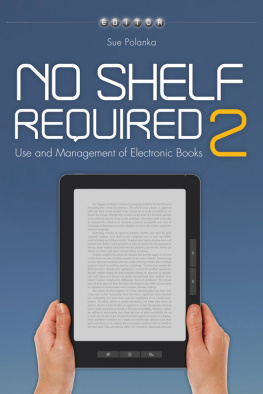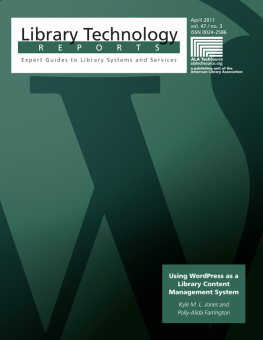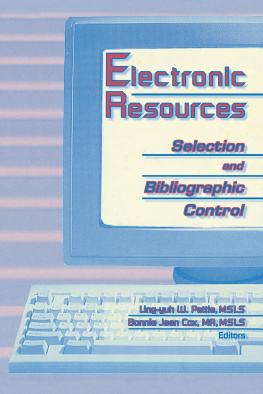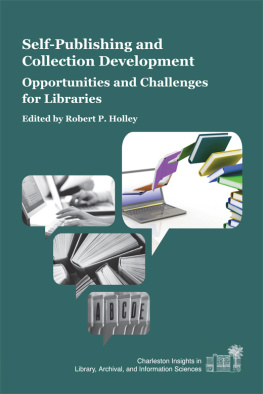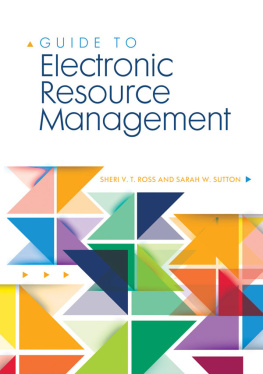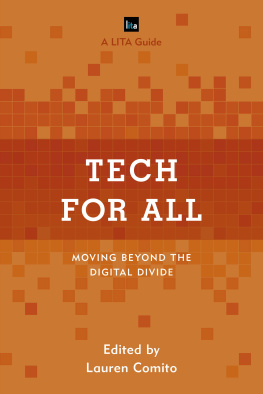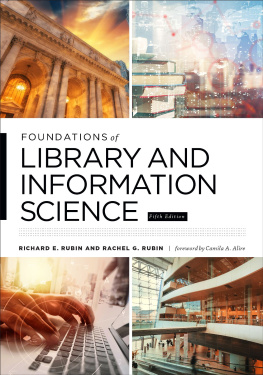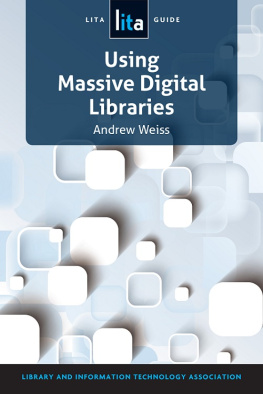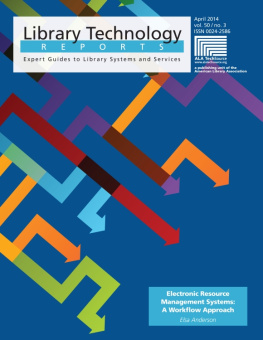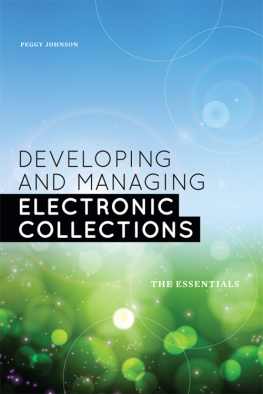No Shelf Required 2
ALA Editions purchases fund advocacy, awareness, and accreditation programs for library professionals worldwide.
No Shelf Required 2
Use and Management of Electronic Books
Edited by Sue Polanka
AMERICAN LIBRARY ASSOCIATION
Chicago 2012
SUE POLANKA created the award-winning blog No Shelf Required, about the issues surrounding e-books for librarians and publishers. Polanka has been a reference and instruction librarian for over twenty years at public, state, and academic libraries in Ohio and Texas and is currently the head of reference and instruction at the Wright State University Libraries in Dayton, Ohio. She edited No Shelf Required: E-books in Libraries (ALA Editions, 2011) and E-Reference Context and Discoverability in Libraries: Issues and Concepts (IGI Publishing, 2012). She has served on Booklists Reference Books Bulletin Editorial Board for over ten years, serving as chair from 2007 to 2010. Her column on electronic reference, Off the Shelf, appears in Booklist quarterly. Sue was named a 2011 Library Journal Mover and Shaker.
2012 by the American Library Association. Any claim of copyright is subject to applicable limitations and exceptions, such as rights of fair use and library copying pursuant to Sections 107 and 108 of the U.S. Copyright Act. No copyright is claimed for content in the public domain, such as works of the U.S. government.
Extensive effort has gone into ensuring the reliability of the information in this book; however, the publisher makes no warranty, express or implied, with respect to the material contained herein.
ISBNs: 978-0-8389-1145-7 (paper); 978-0-8389-9382-8 (PDF); 978-0-8389-9385-9 (ePub); 978-0-8389-9383-5 (Mobipocket); 978-0-8389-9384-2 (Kindle). For more information on digital formats, visit the ALA Store at alastore.ala.org and select eEditions.
Library of Congress Cataloging-in-Publication Data
No Shelf Required 2: Use and Management of Electronic Books / Edited By Sue Polanka.
p.cm.
Includes bibliographical references and index.
ISBN 978-0-8389-1145-7 (alk. paper)
1. Libraries--Special collections--Electronic books. 2. Electronic books. 3. Libraries and electronic publishing. I. Polanka, Sue. II. Title: No shelf required two.
Z692.E4N62 2012
070.5'73--dc23
2011040497
Text design in Charis SIL by Karen Sheets de Gracia. Cover design and composition by Casey Bayer. Cover image pressureUA/Shutterstock, Inc.
CONTENTS
Physical, Digital Library Spaces
Amelia Brunskill
Sarah E. Twill
Ken Petri
E-books, Access, and the Academic Library
Lisa Carlucci Thomas
Business and Content Challenges
Amy Kirchhoff
Alice Crosetto
Steve Kelley
How Books Are Coming Alive in the Digital Environment
Sylvia K. Miller
Lending, Devices, Training, and Budgets
Michael Porter, Matt Weaver, and Bobbi Newman
Reactions to Limits on E-book Access
Michael Porter
Thomas A. Peters
How Libraries Can Push the E-book Envelope to Their Advantage
Joseph Sanchez
Jessica Grim and Allison Gallaher
Technology and E-book Adoption in School Libraries
Carolyn Foote
A Journey of Collaboration and Discovery
Jennifer LaGarde and Christine James
Buffy Hamilton
Kathy Parker
This book would not have been possible without the contributions of twenty knowledgeable, creative, and talented people. I thank the contributors: Amelia Brunskill, Sarah Twill, Ken Petri, Lisa Carlucci Thomas, Amy Kirchhoff, Alice Crosetto, Steve Kelley, Sylvia Miller, Michael Porter, Matt Weaver, Bobbi Newman, Tom Peters, Joseph Sanchez, Jessica Grim, Allison Gallaher, Carolyn Foote, Jennifer LaGarde, Christine James, Buffy Hamilton, and Kathy Parker. I would also like to thank three other individuals who contributed their expertise in a variety of ways: Piper Martin, Kathryn Reynolds, and James Galbraith. Finally, I thank the people who support me the most: my wonderful family, my encouraging boss, and my energetic staff.
December 2010 was a major turning point for the e-book market. When e-reader prices dropped in preparation for the holidays, record numbers of devices were sold (Minzesheimer 2011). In fact, the demand for content was so intense that the Barnes & Noble servers crashed on Christmas Day (Carnoy 2010). This rising e-book trend charged into 2011 and thus far shows no sign of retreat. In March the Barnes & Noble Nook surpassed Amazons Kindle in sales (Chan 2011), and the much awaited Apple iPad2 was also released. Amazon reached another milestone in April, announcing that digital book sales now exceeded sales of all print titles, both hardcover and paperback combined (Stevens 2011). But the surefire sign that e-books had reached the tipping point came in February when the Association of American Publishers declaredfor the first time everthat e-books ranked as the number one format among all categories of trade publishing (Sporkin 2011).
Many librarians predicted this growth trend and were prepared with downloadable e-book content and device lending programs. Library Journals 2010 survey of e-book use in libraries found that 94 percent of academic, 72 percent of public, and 33 percent of school libraries had existing e-book collections (Polanka 2011). Device lending, while not as widespread, was offered by 12 percent of academic, 5 percent of public, and 6 percent of school libraries (Polanka 2011). Preliminary reports of Library Journals not-yet-released 2011 survey indicate 93 percent of libraries are experiencing an increased demand for e-books. Because e-books are now mainstream, libraries have adapted by offering new expanded digital content, device lending programs, and new services.
E-book content, devices, and services have created challenges for libraries as well as opportunities. Increasingly librarians find themselves being forced to deal with issues of licensing, digital rights management, and accessibility, plus device and format incompatibility. At the same time they are acknowledging and implementing new, innovative services in device use and lending, training, and support of self-publishing. No Shelf Required 2 examines how libraries are using and managing e-books and e-reading devices. It expands well beyond the boundaries of the first volume, with sixteen completely new chapters from twenty new contributors. It includes contributions from academic, school, and public librarians; faculty; and vendors. The reader is invited to read the entire work or select chapters that stand on their own. Some important topics may be visited more than once, but in different contexts.
No Shelf Required 2 begins with an examination of the digital library. Ameila Brunskill debates how new technologies have altered the relationship between libraries and their print collections and questions whether e-books are a true replacement for print. She presents the digital-but-not-bookless library through real-world examples from Cushing Academy in Ashburnham, Massachusetts; Stanford University Engineering Library; University of Texas at San Antonio Applied Engineering and Technology Library; and the University of Texas at Austin undergraduate library.
, social work professor Sarah Twill brings her nonlibrarians perspective to e-books. Twill examines both the impact of household income and access to digital technologies on the adoption of electronic content and discusses implications for libraries. She discusses the case example method Can the Jones Family Participate in Digital Technologies? Twill encourages librarians and social service providers to collaborate in order to bridge the digital e-book divide.
Next page
